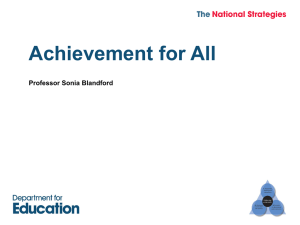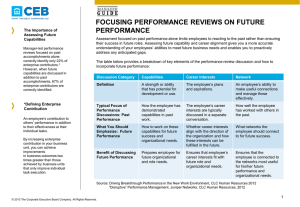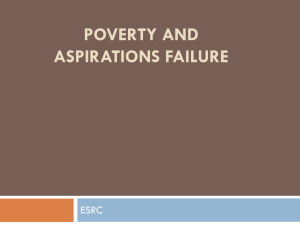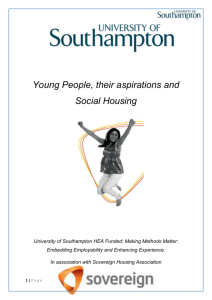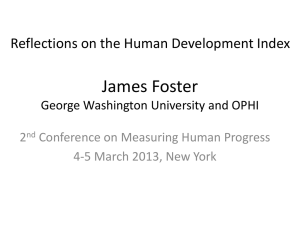Aspirations of Filipino Women Entrepreneurs in
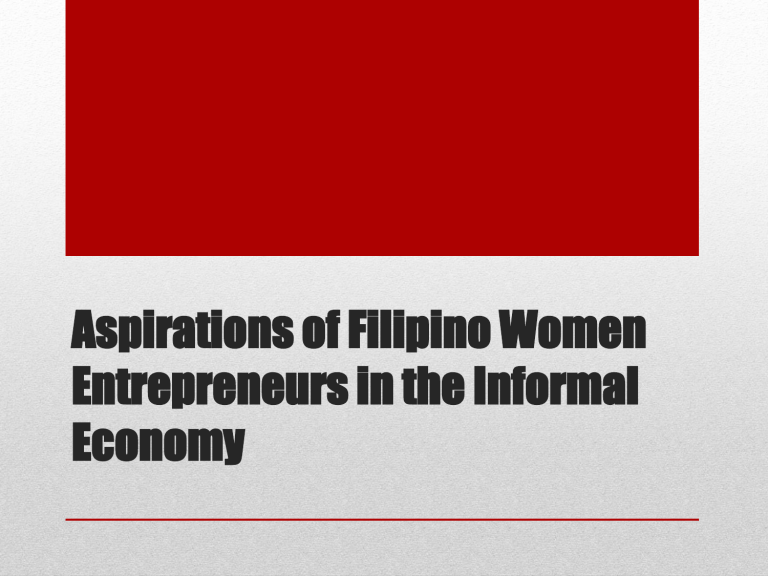
Aspirations of Filipino Women
Entrepreneurs in the Informal
Economy
• “ I just want to have food on the table when I come back from school ”
A little boy from Bagak, Bataan
• “ I want my son to become an engineer ”
A parent from San Pedro, Laguna
• “ My teachers are my problems ”
A secondary dropout from Samar
Motivation
aspiration aspəˈreɪʃ(ə)n/ noun plural noun: aspirations a hope or ambition of achieving something. ( Oxford English Dictionary
1989)
"the needs and aspirations of the people" synonyms: desire , hope , longing , yearning , hankering , urge , wish ;
To aspire means “to seek to attain or accomplish a particular goal”
( Merriam-Webster 2012)
Aspiration defined
• a lack of proactive behavior to better one’s future can in part be explained by constraints faced in the process of forming aspirations
•
The aspiration failure framework attempts to explain why some poorer populations tend to invest less in their own future, despite important potential returns. This lack of investment can in turn be used to explain lack of information, market failures, and low private appropriation of returns, as well as identity issues and psychological factors
Aspiration-failure-theory
Perspectives
Pessimism vs. Aspirations Failure
Aspiration window
Aspiration level and gap
Aspiration failure
Well-being
Aspired
Efforts to improve
Current influenced by the size and composition of one’s social network 𝑔 𝑎, 𝑠 = max( 𝑎−𝑠 𝑎
, 0) ,
Gap
Objectives
•
To understand the aspirations of women entrepreneurs in the informal sector
•
To measure differences in entrepreneurial attitudes activity and aspirations among women in the informal sector
•
To study the consequences for entrepreneurial-oriented behaviour of women (i.e.to invest in income-generating activities) that is linked to the level of aspirations
•
To determine the relationship of the aspirations of women and the different developmental areas including poverty reduction, investment patterns and socio-economic transformation
Research Questions
•
Are there differences in entrepreneurial attitudes, activity and aspirations among women entrepreneurs in the informal sector?
•
Is the aspiration index proposed in this study reliable and valid in measuring the level of aspirations?
•
What is the role played by aspirations in shaping entrepreneuroriented behavior of women in the informal sector?
•
Is there a relationship between aspiration formation and rates of return to investment?
•
Is poverty affected by low levels of aspiration, i.e., do high aspirations reduce poverty?
Background and Introduction
Informal Sector of the Economy
•
Engaged in the production of goods and supply of services and can be household unincorporated enterprises etc.
•
Sub-sectors, among others: microentrepreneurs, home-based workers, vendors, small transport operators, petty retailers, barter traders, small-scale miners etc.
•
Informal sector provides 89% of total employment (NSCB, 2013)
Filipino
Employment in
Different Sectors
Informal
Sector
Formal
Sector
Background and Introduction
Women Aspiration in the Informal Sector
•
33% in the informal sector are women
(NSCB, 2013)
• Exposure to low, irregular income and wages, and poor working conditions
•
Have very limited access to financing, especially formal bank credit and high fixed-cost of credit providers
•
Understanding the aspirations that women entrepreneurs have is of crucial importance to designing policies in developmental areas
•
Aspiration formation can help particularly in the informal sector, and aid in enhancing programs that stimulate depth of entrepreneurial activity.
Informal Sector
Women
Men
Data and Methodology
Data and Survey
•
CBMS (2011) data as baseline data in profiling
•
Randomly sampled women entrepreneurs drawn from the CBMS sample in Tanauan, Batangas, one of provinces in CALABARZON, where we can find 12% of the total labor force involved in the informal sector, either self-employed or operators of own business
• For the pilot, five barangays were randomly sampled: Boot, Hidalgo,
Janopol Oriental, Pantay Matanda, and Laurel.
• Ten female household heads were randomly selected in each barangay
• wholesale/retail trade related workers, housewives
•
45-63 years old
•
Educational attainment: Elementary graduate – 1st year high school
Data and Methodology
Survey Instrument
•
Instrument covering six dimensions
(income, assets, education, children’s education, social benefits and social status) aggregated with individualspecific weights to come up with an aspiration index
•
Perceived minimum and maximum level and the present status of this six dimensions.
•
Two rounds of the survey three weeks apart using the same questionnaires
•
Capacity of the proposed aspiration index to predict entrepreneur-oriented behaviour will be investigated.
•
Reliability of the instrument will also be assessed variation in enumerators’ experience, change of mood of respondent
𝐴 𝑖
= 𝑎 𝑖𝑘 𝑘 𝜌
− 𝜇 𝑘
𝑤 𝑖𝑘 𝑘
• i = respondent
• k = dimension (income, assets, education, children’s education, social benefits and social status)
• 𝑎 𝑖𝑘
= individual’s response on aspiration question
• 𝑤 𝑖𝑘
= weight assigned by respondent
• 𝜇 𝑘
• ρ 𝑘 =
= sample mean for the responses standard deviation for the responses
Income
`
A 1 What is the maximum level of income that one can have in your community?
2 What is the minimum level of income that one can have in your community?
B 1 What is the level of income that you have at present? Please describe.
2 How do you rate in numerical rating your income at the present? (From a scale of 1 to 10 with the minimum level 1 and the maximum level 10 as identified by the respondent in set question A)
1 2 3 4 5 6 7 8 9 10
C.
1
What is the level of income that you would like to achieve in your life? Please describe
2 How do you rate in numerical rating the income you like to achieve in your life? (From a scale of 1 to 10 with the minimum level 1 and the maximum level
Sample questions
1 2 3 4 5 6 7 8 9 10
"Now I would like you to tell me which of these dimensions are the most important to you. Here are 30 coins. Please distribute all 30 coins across the K aspects that we have discussed, according to their importance. No coin in a category means that you do not attach any importance to it. Many coins in a category mean that you attach a high importance to it.”
No. of Coins Dimensions
Income
Assets
Education
Children's Education
Social Benefits
Social Status weighting each dimension according to the value they attach to it.
“A bank representative came to you and offered to lend you any amount of money you ask … "
1 How much would you ask for if the loan were payable in 6 months? individual’s potential demand for credit to invest in family business; short-run vs long-run investments 2 How much would you ask for if the loan were payable in 1 year?
How much would you ask for if the
3 loan were payable in 5 years?
4
How much would you ask for if the loan were payable in 10 years? “
Follow-up question on “what type of
What type of investment would you
5 make if you were given the loan?
investment would you make if you are given the loan?’ capacity of the proposed aspiration index to predict entrepreneur-oriented behavior
•
1. Usability—Can the instrument be administered within standard surveys? Are respondents willing to answer such questions?
•
2. Reliability—Can the instrument be trusted to provide consistent measures of aspiration on repeated applications? To what extent are the obtained answers conditioned by enumerators’ capacities, the questionnaire design, or both?
•
3. Validity—Is the instrument effectively measuring only aspirations? Are the obtained responses in line with expected determinants of aspirations and corresponding future-oriented behavior?
Testing for relaiability, usability, and validity
•
Finding at least one other female household, a peer of the respondent in the same barangay with the same age group and similar level of education
• recording of present mood (from being depressed to very good mood) and perceptions of respondent at the time of interview
•
Tests for reliability and validity requires administering the same questionnaire to the same respondents 3 weeks after the first interview (test-rest procedure, and with and without change of enumerator)
•
Anchoring issues with peer
Challenges
Research study
Step 1: Correlations – an aspiration module was added to the CBMS questionnaire
Step 2: Measurement--An instrument was specifically designed to measure various dimensions of individual-level aspirations and aggregate them altogether.
Step 3: Treatment
Step 4: Experiment
Step 5: Replications
Baseline survey (Aspiration and CBMS)
Treatment
3 types of treatment
•
Documentary
•
Placebo
•
Control
2 levels of treatment
•
Village-level
•
Household-level
